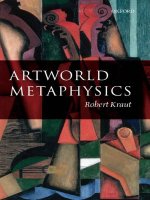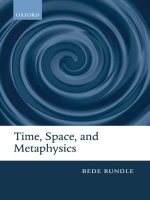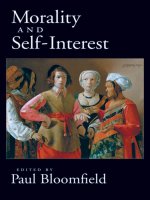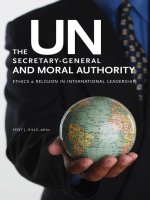- Trang chủ >>
- Khoa Học Tự Nhiên >>
- Vật lý
artworld metaphysics dec 2007
Bạn đang xem bản rút gọn của tài liệu. Xem và tải ngay bản đầy đủ của tài liệu tại đây (1.04 MB, 200 trang )
ARTWORLD METAPHYSICS
This page intentionally left blank
Artworld Metaphysics
ROBERT KRAUT
1
1
Great Clarendon Street, Oxford ox2 6dp
Oxford University Press is a department of the University of Oxford.
It furthers the University’s objective of excellence in research, scholarship,
and education by publishing worldwide in
Oxford New York
Auckland Cape Town Dar es Salaam Hong Kong Karachi
Kuala Lumpur Madrid Melbourne Mexico City Nairobi
New Delhi Shanghai Taipei Toronto
With offices in
Argentina Austria Brazil Chile Czech Republic France Greece
Guatemala Hungary Italy Japan Poland Portugal Singapore
South Korea Switzerland Thailand Turkey Ukraine Vietnam
Oxford is a registered trade mark of Oxford University Press
in the UK and in certain other countries
Published in the United States
by Oxford University Press Inc., New York
© Robert Kraut 2007
The moral rights of the author have been asserted
Database right Oxford University Press (maker)
First published 2007
All rights reserved. No part of this publication may be reproduced,
stored in a retrieval system, or transmitted, in any form or by any means,
without the prior permission in writing of Oxford University Press,
or as expressly permitted by law, or under terms agreed with the appropriate
reprographics rights organization. Enquiries concerning reproduction
outside the scope of the above should be sent to the Rights Department,
Oxford University Press, at the address above
You must not circulate this book in any other binding or cover
and you must impose the same condition on any acquirer
British Library Cataloguing in Publication Data
Data available
Library of Congress Cataloging in Publication Data
Data available
Typeset by Laserwords Private Limited, Chennai, India
Printed in Great Britain
on acid-free paper by
Biddles Ltd., King’s Lynn, Norfolk
ISBN978–0–19–922812–6
13579108642
for Robin Ann
This page intentionally left blank
Preface and Acknowledgments
The artworld is a complicated place. It contains acts of artistic cre-
ation, interpretation, evaluation, preservation, misunderstanding, and
condemnation. It contains club-owners violating contracts, sound engi-
neers modifying recorded material, painters struggling for recognition,
dancers starving themselves to maintain requisite body mass, poets
substituting one phrase for another, and nightclub patrons too stupid
and/or musically illiterate to remain attentive during sensitively per-
formed ballads. The artworld contains citizens seeking to preserve
cast-iron facades in their neighborhoods, parents attending dramat-
ic performances at their children’s schools, museum patrons puzzled
about an exhibited ‘‘hyperrealist’’ sculpture, and amplifiers blowing
output tubes during concerts. The artworld contains raging contro-
versies about the artistic value of various objects, performances, and
achievements.
The goal in what follows is to turn a critical reflective eye upon
various aspects of the artworld, and to articulate some of the problems,
principles, and norms implicit in the actual practices of artistic creation,
interpretation, evaluation, and commodification. Most of the chapters
presuppose substantial background in systematic philosophy: the issues
and arguments draw heavily upon metaphysics, moral theory, episte-
mology, philosophy of language and philosophy of mind. Part of the
goal is to clarify what actually happens in the artworld (rather than what
certain theorists claim to happen in the artworld); thus some of the
chapters assume reasonable familiarity with various artforms.
Biographical statements are, for the most part, out of place in analytic
philosophy: personal details of a theorist’s life are tangential to the
soundness of arguments and irrelevant to the plausibility of explanatory
theories. But occasionally the author’s situation bears upon the content
of the project. An author might, for example, seek to provide a
holistically adequate semantic theory for a certain fragment of epistemic
discourse; and perhaps different sociocultural and/or regional groups
uphold different norms and permissible inferences regarding attributions
of knowledge. If such variation obtains, the theorist’s background is
potentially relevant: if only to provide the reader with a better glimpse
of what is being counted as data, what inferential norms are qualifying
viii Preface and Acknowledgments
as worthy of explanation, and perhaps even what is counting as an
adequate explanation.
I come to philosophy from the music business. My work as a
jazz guitarist spans the better part of four decades, and serves as the
impetus for the present inquiry. My views about aesthetic theory
result, in part, from experiences touring, recording, performing, and
struggling with the internal dynamics of musicians, bands, audiences,
club-owners, critics, and other aspects of the music world. I am neither
musicologist, neuroscientist, music theorist, music psychologist, nor
music historian: the academic side of the music world is unfamiliar to
me. My perspective as a working player hardly entails incorrigible grasp
of relevant principles and theories—one can easily be mistaken about
the theoretical underpinnings of one’s own practices. Nevertheless, this
book results from the efforts of an engaged practitioner to achieve
reflective awareness regarding the very practices that sustain him; the
possibility of such awareness is a theme that recurs throughout what
follows.
Jazz performance is an essentially interactive endeavor; anything of
value I have contributed to the music world owes much to the musicians
with whom I have been privileged to play and the audiences with which
I have been privileged to share my energies and ideas. Fortunately or
unfortunately, I bring the ensemble temperament to the academic side
of my life, and my philosophical views emerge from dialogue with
others. I am grateful to the many people who have been willing to share
their thoughts and help me formulate my own. I thank Wilfrid Sellars,
who first helped me understand what it is to think systematically about
a philosophical problem, and Jaakko Hintikka, Hector-Neri Casta
˜
neda,
and David Lewis, who encouraged me to reconcile the demands of
systematic theory with the need for rigor and clarity. More recently I
have benefited from frequent discussion with Neil Tennant, Stewart
Shapiro, and Simon Blackburn. Collaboration with my students Henry
Pratt, Cristina Moisa, and Patrick Hoffman has also been helpful. My
son Ian Matthew and my daughter Emily Vachon have provided valuable
dialogue and counterpoint, as well as a rich supply of unbiased data. I am
deeply grateful to many others—both musicians and academics—who,
over the years, have helped me think about various aspects of the
project: these people are specifically cited in connection with individual
chapters.
There is nothing easy or comfortable about simultaneously pursuing
the life of a musician and that of an academic philosopher: the norms
Preface and Acknowledgments ix
sustained within one realm frequently conflict with those of the other.
Throughout my efforts to reconcile the demands of these worlds there is
one person with whom I have consistently shared the joys and indignities
of both, and whose understanding and support have been a constant
source of encouragement. My wife Robin Ann is the love of both my
lives; it is to her that I dedicate this work, with ongoing appreciation
and adoration.
This page intentionally left blank
Contents
Preface and Acknowledgments vii
1. Introduction: Artworld Data and Aesthetic Theory 1
2. Stepping Out: Playback and Inversion 25
3. Why Does Jazz Matter to Aesthetic Theory? 44
4. Emotions in the Music 66
5. Interpretation and the Ontology of Art 98
6. Pluralism and Understanding 121
7. Objectivity, Ontology 151
8. Postscript: Language, Speaker, Artist 177
Index 183
This page intentionally left blank
1
Introduction: Artworld Data
and Aesthetic Theory
Arthur Danto, noting the ‘‘general dismal appraisal of aesthetics’’ as an
academic discipline, observes that
the ‘‘dreariness of aesthetics’’ was diagnosed as due to the effort of philosophers
to find a definition of art, and a number of philosophical critics, much under
the influence of Wittgenstein, contended that such a definition was neither
possible nor necessary.¹
Surely not all work in aesthetic theory qualifies as ‘‘dreary’’ or warrants
‘‘dismal appraisal’’: doubtless the field contains creative and insightful
contributions. Nevertheless, Danto here recognizes a sentiment occa-
sionally broached by others: a general skepticism about the value and
prospects of aesthetic theory. Stuart Hampshire asks ‘‘What is the
subject-matter of aesthetics?’’ and replies ‘‘Perhaps there is no subject-
matter; this would fully explain the poverty and weakness of the books.’’²
Nicholas Wolterstorff registers similar concerns:
It is beyond disputethat theglory of twentieth-century analytic philosophy is not
revealed in the field of the philosophy of art. If one is on the lookout for analytic
philosophy’s greatest attainments, one must look elsewhere. Why is that?³
Diagnosis aside, Wolterstorff takes the marginal status of aesthetic
theory as a datum to be explained. Here is a related observation by Mary
Devereaux:
[P]hilosophers widely regard aesthetics as a marginal field. Aesthetics is marginal
not only in the relatively benign sense that it lies at the edge, or border, of the
¹ Arthur Danto, ‘‘Art, Philosophy, and the Philosophy of Art,’’ Humanities,4,no.1
(Feb. 1983), 1–2.
² Stuart Hampshire, ‘‘Logic and Appreciation,’’ repr. in W. E. Kennick (ed.), Art and
Philosophy (New York: St. Martin’s Press, 1979), 651.
³ Nicholas Wolterstorff, ‘‘Philosophy of Art After Analysis and Romanticism,’’ Journal
of Aesthetics and Art Criticism, 46 (1987), 151.
2 Artworld Metaphysics
discipline, but also in the additional, more troubling, sense that it is deemed
philosophically unimportant. In this respect, aesthetics contrasts with areas like
the philosophy of mathematics, a field which, while marginal in the first sense,
is widely regarded as philosophically important. A few years ago Arthur Danto
quipped, and he wasn’t that far off the mark, that the position of aesthetics
is ‘‘about as low on the scale of philosophical undertakings as bugs are in the
chain of being.’’⁴
Devereaux then asks ‘‘What are we to make of this situation?,’’ and
proceeds to defend the philosophical importance of aesthetics: her
strategy involves rehearsing the philosophical importance of art, the
relevance of humanistic inquiry to philosophy, the importance of
value theory, and the recognition that ‘‘aesthetics is part of value
theory.’’
Complaints about the quality, legitimacy, and/or status of aesthetic
theory are not new. Almost a century ago Clive Bell lamented the poor
state of art theory and offered an explanation:
He who would elaborate a plausible theory of aesthetics must possess two
qualities—artistic sensibility and a turn for clear thinking unfortunately,
robust intellects and delicate sensibilities are not inseparable.⁵
After discussing those ‘‘robust intellects’’ lacking in aesthetic sensibil-
ity, Bell turns to those with the reverse deficiency:
[P]eople who respond immediately and surely to works of art are often quite
as incapable of talking sense about aesthetics. Their heads are not always very
clear. They possess the data on which any system must be based; but, generally,
they want the power that draws correct inferences from true data.⁶
Bell is surely right that effective theorizing demands both sensitivity
to the data and skill in theory construction: but aesthetics is not
unique in occasionally attracting theorists who fall short. If there is
legitimacy to the claim that aesthetic theory is ‘‘dreary,’’ ‘‘marginalized,’’
and/or otherwise flawed, deeper factors might be at work. My goal
is to identify and discuss two such factors: a curious tendency to
collapse the distinction between artworld practices and theoretical
reflections upon them, and an equally curious tendency to ignore
relevant data.
⁴ Mary Devereaux, ‘‘The Philosophical Status of Aesthetics,’’ available online at
www.aesthetics-online.org/ideas/devereaux.html
⁵ Clive Bell, Art (New York: Capricorn Books, 1958; first published 1913), 15.
⁶ Ibid. 15–16.
Artworld Data and Aesthetic Theory 3
I
Devereaux’s classification of aesthetics as ‘‘part of value theory’’ is puz-
zling: it suggests a misleading picture of what the philosopher of art is
up to. Aesthetics is no more part of ‘‘value theory’’ than is epistemology,
the semantics of natural language, or the philosophy of mathematics.
The task of the philosopher of art is to provide an accurate systematic
picture of the artworld, making explicit the norms sustained therein:
norms that govern recognition, evaluation, and interpretation of artis-
tic objects and events. Admittedly the artworld contains criticism and
evaluation—as do the worlds of knowledge attribution, informal argu-
mentation, and mathematical proof—and studying the latter domains
admittedly requires focus on normative assessment (whether epistemic,
inductive, or proof-theoretic). But this hardly suggests that these areas
are usefully subsumed under ‘‘value theory.’’⁷
The issue goes beyond classification. If some aesthetic theorists see
themselves as engaged in the business of art criticism and evaluation—if
the philosopher of art is somehow portrayed as an art critic—no wonder
there are ‘‘marginalization’’ problems. Whatever else the philosophy of
art might be, it is not to be conflated with art criticism—any more
than the philosophy of physics is to be conflated with physics, or
the philosophy of mathematics is to be conflated with mathematics.⁸
Participation in a practice is one thing, analytical reflection upon that
practice quite another.
Or so I say. Obviously, engagement in a practice—whether epistemic
appraisal, mathematical proof, art criticism, or marriage—involves
deployment of a certain amount of theory; a reflective participant will
be aware of various aspects of the form of life in which he or she is
engaged. Still, there is an important contrast between participating in
a practice and reflecting upon the principles, norms, and behavioral
uniformities constitutive of that practice. Physics is not the philosophy
of physics (however difficult it might occasionally be to draw the line);
⁷ Similar opposition to ‘‘aesthetics as value theory’’ is registered in Kendall Walton’s
‘‘How Marvelous! Toward a Theory of Aesthetic Value,’’ Journal of Aesthetics and Art
Criticism, 51 (1993), 499–510; my objections on this front were formulated long before
I became aware of Walton’s paper.
⁸ These contrasts are subtle and controversial. For a well-informed and provoca-
tive discussion see Stewart Shapiro, ‘‘Mathematics and Philosophy of Mathematics,’’
Philosophia Mathematica (3) 2 (1994), 148–60.
4 Artworld Metaphysics
mathematics is not the philosophy of mathematics; art criticism is not
the philosophy of art (however difficult it might occasionally be to draw
the line).
Playwright Harold Pinter provides a glorious (and characteristically
vicious) description of the contrast between participation and reflective
awareness, as Teddy—a professor of philosophy—spells out his special
perspective:
It’s nothing to do with the question of intelligence. It’s a way of being able
to look at the world. It’s a question of how far you can operate on things
and not in things. I mean it’s a question of your capacity to ally the two, to
relate the two, to balance the two. To see, to be able to see.I’mtheonewho
can see. That’s why I can write my critical works You’re just objects. You
just move about. I can observe it. I can see what you do. It’s the same as I
do.Butyou’relostinit.Youwon’tgetmebeing I won’t be lost in it.⁹
Teddy, in other words, not only engages in linguistic activity (e.g.)
but engages in ‘‘higher-order’’ systematic reflection upon such activity:
this he does via occasional forays into semantic and syntactic theory.
Perhaps Teddy wonders whether his use of natural kind predicates carries
commitment to Platonic universals, or whether his moral discourse
is best construed descriptively (serving to ‘‘get at the moral facts’’)
or expressively (serving to ‘‘manifest moral sentiments’’); perhaps he
spends his darker moments wondering whether realism or deflationism
provides the better explanation of his ‘truth’ predicate, or whether proper
names in his lexicon are semantically equivalent to definite descriptions;
he might even flirt with revisionism, wondering whether to abandon
his commitments to bivalence and reductio ad absurdum.Whatever
his conundrums, Teddy not only operates ‘‘in things’’ (by being a
competent speaker) but ‘‘on things’’ (by being a competent semantic
theorist, and reflecting upon the norms that constrain him). He ‘‘moves
about’’ the space of linguistic norms as others do; but occasionally he
goes reflective, thereby preventing him from being ‘‘lost in it.’’
Strong imagery. It prompts deep metaphysical qualms about the
very possibility of ‘‘exiting’’ a mode of discourse and surveying it
from some ‘‘external’’ perspective. But such imagery—endemic to the
entire Tarski–Carnap tradition of languages and metalanguages, and
perpetuated in the Quine–Davidson tradition of radical translation
and radical interpretation—does not assume the possibility of a View
⁹ Harold Pinter, The Homecoming (New York: Grove Press, 1965), 61–2.
Artworld Data and Aesthetic Theory 5
from Nowhere, or Absolute Standpoint, or God’s-Eye Perspective. The
imagery only assumes the possibility of circumscribing a region of
discourse and theorizing about it from some external vantage point.
This more modest possibility is itself laced with controversy, and is
critically surveyed in the following chapter.
Granted: art criticism, evaluation, and creation are saturated with
theory. Participation in the artworld requires background assumptions
about the nature and purpose of art, the relevance of genre categories,
the contextual determinants of content, the artistic ‘‘problems’’ a work
purports to solve, and so on. One need not dispute the role of theory
in practice, the ‘‘theory-laden’’ character of observation and intention,
or the impossibility of engaging in institutional activities without
substantial theoretical baggage. The point is not that participation in
the artworld—as artist, critic, or consumer—is somehow ‘‘theory-
neutral.’’ It is not. The point, rather, is that participation in the artworld
is not to be conflated with theoretical reflection upon participation in
the artworld.
But the contrast is frequently ignored. Aaron Ridley, for example,
rails against Goodman-inspired individuative questions about whether
a musical performance is an instance of a given work, and laments
that contemporary philosophers of music generally neglect ‘‘evaluative
issues’’:
The question whether this or that performance, or style of performance, is
actually any good, or is minimally worth listening to, is scarcely raised If
one is serious about the philosophy of music, this last fact should strike one as
scandalous.¹⁰
I don’t think so. It is not scandalous that recent work in the philosophy
of mathematics contains not a hint about how to prove Fermat’s Last
Theorem; nor is it scandalous that philosophers of physics ‘‘scarcely
raise’’ questions about which elementary particles are likely to exist,
given the experimental data. Ridley has collapsed the philosophy of
art into art criticism: unlike Ridley, when I wish to know whether a
musical performance is ‘‘actually any good,’’ I read music criticism, not
the philosophy of music.
Thus there is resonance between the sentiments of Ridley and
Devereaux: each of them chooses words that suggest a conflation of
¹⁰ Aaron Ridley, ‘‘Against Musical Ontology,’’ Journal of Philosophy, 100 (Apr.
2003), 208.
6 Artworld Metaphysics
aesthetic theory with the activities of art criticism and evaluation.
This kind of conflation—between artistic practice and theoretical
reflection upon that practice—is conducive to the marginalization of
aesthetic theory, insofar as it prompts the accusation that philosophers
of art are doing art criticism rather than philosophy: they should, for
example, be reflecting upon critical practice—codifying the norms and
uniformities sustained within it—rather than engaging in it. Even if
actual involvement in the production and/or evaluation of artworks
provides requisite data for theorizing responsibly about these practices,
the evaluation of art is not the philosophy of art; if it is permitted to
collapse into it, no wonder there is marginalization of aesthetic theory.
II
This conception of aesthetic theory—as descriptive and explanatory of
artworld practice—is continuous with much of what happens through-
out a range of philosophical subdisciplines; but it encounters skeptical
resistance from other quarters. The very idea of reflective awareness is
somehow suspect; Terry Eagleton, for example, wonders whether such
theorizing is even possible:
[T]heory is in one sense nothing more than the moment when those practices
[which have ‘‘run into trouble’’ and ‘‘need to rethink themselves’’] are forced
for the first time to take themselves as the object of their own inquiry. There is
thus always something inescapably narcissistic about it The emergence of
theory is the moment when a practice begins to curve back upon itself, so as to
scrutinize its own conditions of possibility; and since this is in any fundamental
way impossible, as we cannot after all pick ourselves up by our own bootstraps,
or examine our life-forms with the clinical detachment of a Venusian, theory is
always in some ultimate sense a self-defeating enterprise.¹¹
Eagleton’s worries about ‘‘the possibility of theory’’ are, it will emerge,
alien to the presuppositions of much contemporary analytic philosophy;
nevertheless, his criticisms invite helpful clarification.
Note first that Eagleton’s description of the reflective theoretical
standpoint is peculiar: aesthetic theories of the sort considered here, for
example, need hardly be formulated from the standpoint of a ‘‘clinically
detached Venusian’’; the standpoint of a reflective observer will suffice.
¹¹ Terry Eagleton, Literary Theory: An Introduction , 2nd edn. (Minneapolis: University
of Minnesota Press, 1996), 190.
Artworld Data and Aesthetic Theory 7
Note also the oddity of Eagleton’s criticism: oneexpects the accusation
to be that theory is ‘‘self-legitimizing’’ (rather than ‘‘self-defeating’’)
insofar as it contains within itself the very apparatus that it purports to
study from a distance, and thus—of necessity—treats that apparatus
as legitimate. Here the problem resembles that generated by Quinean
efforts to ‘‘naturalize’’ epistemology, wherein the norms and principles
under consideration are themselves deployed during the investigation.
These oddities aside, Eagleton is on to something: if aesthetic the-
ory were in the business of articulating ‘‘conditions of possibility’’ for
artworld practices, and if such articulation were intended to play a justifi-
catory role—that is, as serving to legitimate those practices—perhaps any
such theory would be contaminated with circularity. Thus the question:
Are aesthetic theoriesjustificatory, or merely descriptiveand explanatory?
Clearly, some work designated as ‘‘theoretical’’ is vulnerable to
Eagleton’s criticisms. Consider Roger Scruton’s indictments of recent
popular music as resulting from ‘‘a democratic culture, which sacrifices
good taste to popularity’’ and as manifesting general societal decline.¹²
Theodore Gracyk summarizes Scruton’s position:
[Recent] popular music represents a repudiation of taste, for it is deficient in the
areas of melody, harmony, and rhythm. Scruton calls it ‘‘a kind of negation of
music, a dehumanizing of the spirit of song.’’ It invites a sympathetic response
to a decadent, disordered community.¹³
Scruton’s ‘‘philosophy of music’’ is, in part, devoted to critical assess-
ment, praise and condemnation, and reasons for acceptance and rejection
of specific artistic performances and/or genres. But Scruton here engages
in art criticism, not aesthetic theory. The contrast is vital: as vital as
that between substantive moral dispute and meta-ethics, or between
ordinary linguistic activity and theoretical reflection upon such.
If aesthetic theory were in the business of legitimizing artworld prac-
tices, rather than describing, codifying, and explaining them, Eagleton’s
skepticism might be warranted in light of work such as Scruton’s which
is, in part, art criticism.¹⁴ But art criticism is not aesthetic theory. An
analogy with natural language is helpful.
¹² Roger Scruton, The Aesthetics of Music (New York: Oxford University Press, 1997).
¹³ Theodore Gracyk, ‘‘Music’s Worldly Uses, or How I Learned to Stop Worrying
and to Love Led Zeppelin,’’ in A. Neill and A. Ridley (eds.), Arguing About Art (London
and New York: Routledge, 2002), 136.
¹⁴ Of course there is good and bad criticism: Scruton’s critical assessments might be
faulted for provinciality and failure to accommodate essential aspects of the genres he
condemns.
8 Artworld Metaphysics
Consider a linguistic practice that seeks to codify aspects of itself in
the form of a dictionary. The dictionary encodes information about the
way things are done: the semantic equivalences that enable speakers to
engage in fluid dialogue. Perhaps the dictionary is originally prompted
by inner turmoil: communication breakdowns and militant struggles
about which words are ‘‘offensive.’’ The dictionary constitutes a partial
theory of the language: far from providing a ‘‘neutral’’ tribunal for
resolving disputes, it likely manifests prejudices about what is correct.
This does not entail that dictionaries are impossible or self-defeating; it
only suggests a need for caution in specifying what a dictionary is (or
is not) supposed to do. Perhaps aesthetic theories are rather like dictio-
naries: though they might occasionally be invoked to legitimize certain
practices, their primary function is to provide regimented descriptions
of those practices and the principles that underlie them. Eagleton sees
‘‘theory’’ as a failed or self-deceived effort toward justification, and
objects that
our forms of life are relative, ungrounded, self-sustaining, made up of mere
cultural convention and tradition, without any identifiable origin or grandiose
goal; and ‘‘theory’’, at least for the more conservative brands of the creed, is for
the most part just a high-sounding way of rationalizing these inherited habits
and institutions. We cannot found our activities rationally ¹⁵
But he is wrong about the purpose of theory: it is not in the business of
‘‘rationalizing habits and institutions,’’ any more than dictionaries
are in that business. Such theories are, rather, in the business of
description, codification, and articulation of artworld practices. There
is no presupposition—of the sort criticized by Eagleton—that the
theories identify fundamental metaphysical facts that confer legitimacy
on those practices. Legitimization is not the task of aesthetic theory;
thus such theory is safe from any marginalization that might result from
sentiments such as Eagleton’s.
But the plot thickens when the postmodern rhetoric gains mo-
mentum:
There is no overarching totality, rationality or fixed centre to human life, no
metalanguage which can capture its endless variety, just a plurality of cultures
and narratives which cannot be hierarchically ordered or ‘‘privileged’’, and
which must consequently respect the inviolable ‘‘otherness’’ of ways of doing
things which are not their own.¹⁶
¹⁵ Eagleton, Literary Theory, 201. ¹⁶ Ibid.
Artworld Data and Aesthetic Theory 9
This is confused. Most mathematicians, linguists, and semantic theorists
comfortably invoke metalanguages without—at least knowingly—
falling prey to colonialism. It is hard to see how Eagleton could acqui-
esce in logicians’ efforts to specify formal grammars and recursive truth
definitions, or even provide truth-tabular semantics for classical proposi-
tional languages. Nor—on less technical fronts—could he comfortably
participate in a wide range of traditional philosophical discussions.
Consider disputes about the nature of moral normativity. It is com-
mon to distinguish ‘‘first-order’’ claims made within moral discourse
from ‘‘higher-order’’ claims made about moral discourse. Admittedly
there are puzzle cases: Simon Blackburn and John Mackie disagree,
for example, about whether claims to moral objectivity are embedded
within moral discourse (thus rendering them first-order) or within a
higher-order metaphysical theory purporting to explain the internal
trappings of moral discourse.¹⁷ But there are also straightforward cases:
non-cognitivism—a familiar artifact of empiricist and/or naturalistic
philosophy—portrays moral indicatives as serving to manifest senti-
ments rather than describe facts, and is obviously a higher-order theory.
Non-cognitivism is not a substantive moral claim; it is a theoretical
explanation of what we are doing when we make substantive moral
claims. Whatever the merits of such explanation, it is not in the business
of ‘‘rationalizing’’ moral disputation or justifying any particular moral
assessment; it is a meta-ethical theory, purporting to explain norma-
tive discourse and practice from a naturalistic perspective. To think
otherwise is to confuse first-order discourse—the phenomenon to be
explained—with the higher-order theory that purports to explain it; if
Eagleton is thus confused, his indictments provide no compelling basis
for skepticism about aesthetic theory.
III
Admittedly the contrast between ‘‘first-order’’ practice—artistic or oth-
erwise—and ‘‘higher-order’’ theoretical reflection upon it is profoundly
puzzling, despite its popularity in moral theory, linguistics, and else-
where. The imagery of stepping outside a discourse and surveying it
¹⁷ J. L. Mackie, ‘‘The Subjectivity of Values,’’ in Ethics: Inventing Right and Wrong
(New York: Penguin, 1977), ch. 1; Simon Blackburn, ‘‘Errors and the Phenomenology
of Value,’’ in T. Honderich (ed.), Morality and Objectivity (London: Routledge & Kegan
Paul, 1985), 1–22.
10 Artworld Metaphysics
(without distortion) from an external perspective is unclear. It is hard to
say ‘‘where we stand’’ in conducting such inquiries, or which resources
we can import without circularity, or how to measure success, or even
whether we have succeeded in stepping outside the discourse in ques-
tion.¹⁸ External viewpoints are not always available: certain regions of
discourse cannot be encapsulated, climbed out of, and surveyed from
the outside (example: any discourse adequate for an explanation of
rational norms is itself constrained by rational norms; there exists no
sanitized, non-rational haven from which rationality can be adequately
surveyed).¹⁹ Call this the No Exit phenomenon. In other cases—for
example, the analysis of elementary arithmetic in terms of set theory—it
is possible to bracket a relatively autonomous and segregable region of
discourse and survey it from without.
The alleged contrast between ‘‘first-order practice’’ and ‘‘higher-order
reflection’’ is rendered even more puzzling by the fact that participation
in any form of life involves a certain amount of theory: a sense of what
one is doing, why one ought to do it, and what sorts of conditions are
acceptable or intolerable. Thus any attempt to define a ‘‘cut’’ between
the practice and the (possibly incorrect) explanatory and/or justificatory
‘‘external’’ reflections upon the practice seems futile. Consider an art-
world example: Picasso’s Guernica is prompted by ‘‘theoretical’’ views
about human nature, the limits of sovereignty, and the demands of fair-
ness; these theoretical views are constitutive of artistic expression—part
of the ‘‘first-order’’ artistic/political practice—not an artifact of some
‘‘higher-order’’ explanatory reflection upon that practice. Such cases
suggest that institutional practices are so inextricably laden with reflec-
tive theoretical considerations that the touted contrast between practice
and theoretical reflection upon that practice is implausible. But other
examples pull in opposite directions: many musicians perform brilliant-
ly despite a consummate lack of reflective self-awareness concerning
the theoretical underpinnings of their performance; most competent
natural-language speakers have little reflective knowledge of semantic or
syntactic theory; and so on. The best way to proceed is on a case-by-case
basis.
¹⁸ Some reject the very contrast between ‘‘first-order’’ discourse and a ‘‘higher-order’’
standpoint from which it can bereflected uponand theorized about;see Ronald Dworkin,
‘‘Objectivity and Truth: You’d Better Believe It,’’ Philosophy and Public Affairs, 25, no. 2
(Spring 1996), 87–139.
¹⁹ Thomas Nagel articulated such skepticism in ‘‘The Last Word: Two Lectures on
Reason,’’ delivered as the Kant Lectures at Stanford University on 13 and 14 Dec. 1995.
Artworld Data and Aesthetic Theory 11
Given these reflections on the contrast between a practice and a
theory about that practice, either of two strategies suffices to defuse
Eagleton’s qualms about reflective theorizing: (1) argue that artworld
practices can, in fact, be exited and surveyed from an ‘‘external’’ vantage
point; thus aesthetic theory does not, after all, involve deployment of the
very resources under study. Alternatively, (2) argue that exiting artworld
practices is no prerequisite for coherently theorizing about them: after
all, one need not exit English in order to theorize about English, and
one need not abandon Neurath’s ship in order to study its structure.
Additional questions—profound questions—lurk here about philo-
sophical method. Explanations of an institutional practice—the art-
world included—are multifaceted. They involve descriptions of the
commitments formulable within it, the epistemology and ontology it
embodies, the nature of its interfaces with other practices, the stimulato-
ry conditions correlated with reports cast in its vocabulary, and the like.
Some such explanations are conservative: they allow the practice to go on
as before, even when practitioners come to believe the explanations. But
other explanations of a practice have the fascinating feature of not being
coherently conjoinable with continued participation in that practice:
the explanation somehow undermines the very phenomenon it seeks
to explain. Such explanations are non-conservative. Consider Freudian
or Marxist explanations of religious practice: any reflective religious
practitioner who comes to endorse such explanations is likely to have
considerable misgivings about returning to the practice (‘‘in good faith’’)
and going on as before. Call this the No Return phenomenon.
In the context of aesthetic theory, consider Arnold Isenberg’s account
of the function of reasons in art criticism: such reasons allegedly serve
to induce a way of apprehending an artwork, directing the audience’s
attention to aesthetic qualities that might have been missed.²⁰ Thus the
truth of critical reasons (if such reasons are even truth-evaluable) adds
no weight to an evaluative verdict. Isenberg’s theory of critical practice
is controversial: perhaps it effectively explains art-evaluative realities,
but perhaps it does not. Suppose a working critic, having learned of
Isenberg’s account, responds by saying: ‘‘If that is what I am doing
when I provide critical reasons in art-evaluative discourse, I shall do
so no more’’; and suppose this response to Isenberg’s theory is fairly
uniform among critics. Methodological question: does the prevalence
²⁰ Arnold Isenberg, ‘‘Critical Communication,’’ Philosophical Review, 58 (1949):
330–44.
12 Artworld Metaphysics
of such response disconfirm Isenberg’s theory? Not clear: perhaps it is
no requirement that a philosophical theory of a practice be such that
coming to believe the theory is consistent with continued engagement
(relatively unchanged) in the practice. Perhaps an aesthetic theory is
rather like a psychological explanation spawned during psychoanalysis:
a correct theory of Walter—his self-image included—need not be such
that, upon learning the theory, he goes on as before. Perhaps correct
philosophical description and explanation of institutional practice need
not be conservative.
I do not know. These are profound questions concerning the shape
of philosophical explanation; they apply across a wide range of philo-
sophical areas and cast no special cloud over aesthetic theory. Indeed,
any philosophical project that involves theorizing about a fragment of
discourse from an external explanatory perspective must sooner or later
confront questions about the methodological constraints on such expla-
nations. There is no special basis here for skepticism about aesthetic
theory, construed as codification and explanation of artworld practice.
IV
The contrast between engagement in the artworld and theoretical reflec-
tion upon such engagement is complicated by the fact that many
artworks are themselves reflective commentaries upon the norms and
mechanics of the artworld: thus the line between artistic practice and
aesthetic theory is difficult to draw. Rene Magritte’s surrealist paintings
focus on the very idea of aboutness, and the contrast between repre-
sentational mechanisms (both linguistic and perceptual) and the items
represented; de Chirico’s ‘‘metaphysical’’ art speculates on fundamental
realities inaccessible to explicit depiction; Duchamp’s work provides
ongoing commentary upon commodification and the contrast between
art and non-art; Lichtenstein’s paintings are comments upon Abstract
Expressionism and the methods by which mass media portray their
subjects; Mondrian explores tensions generated by painterly resources
(e.g. tendencies of colors to advance or recede from the picture plane)
and the possibility of equilibrium; Kaufman and Jonze’s film Adap-
tation is a curiously self-referential study of filmmaking. And so on.
Such art—often designated as ‘‘art about art’’—involves modernist
self-awareness of the sort described by Clement Greenberg as ‘‘the use
of the characteristic methods of a discipline to criticize the discipline









